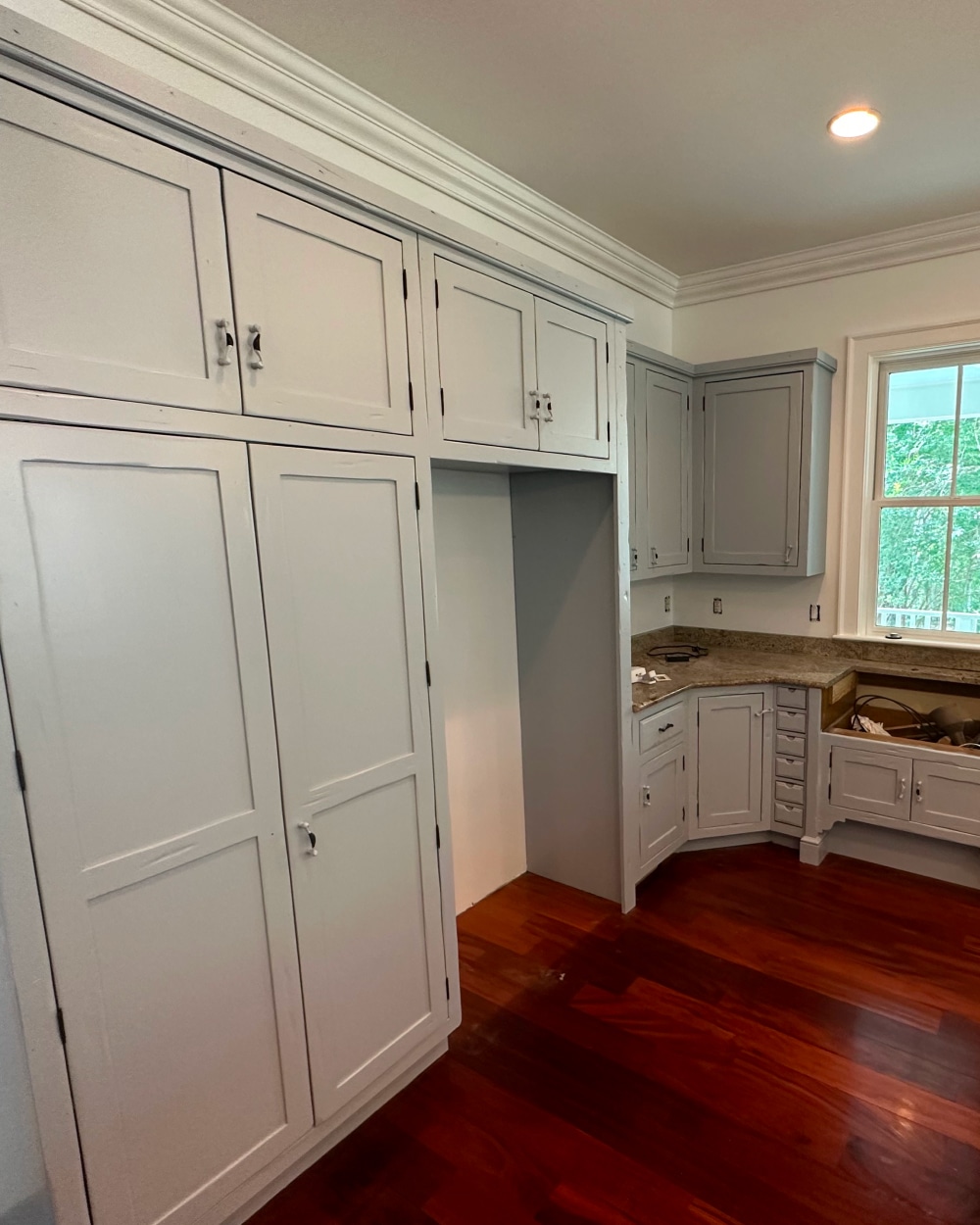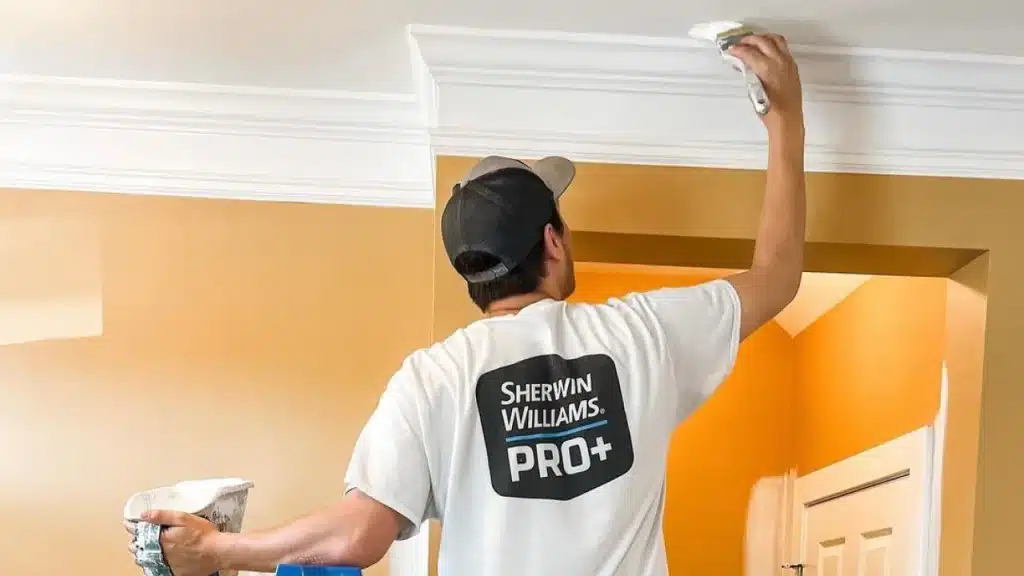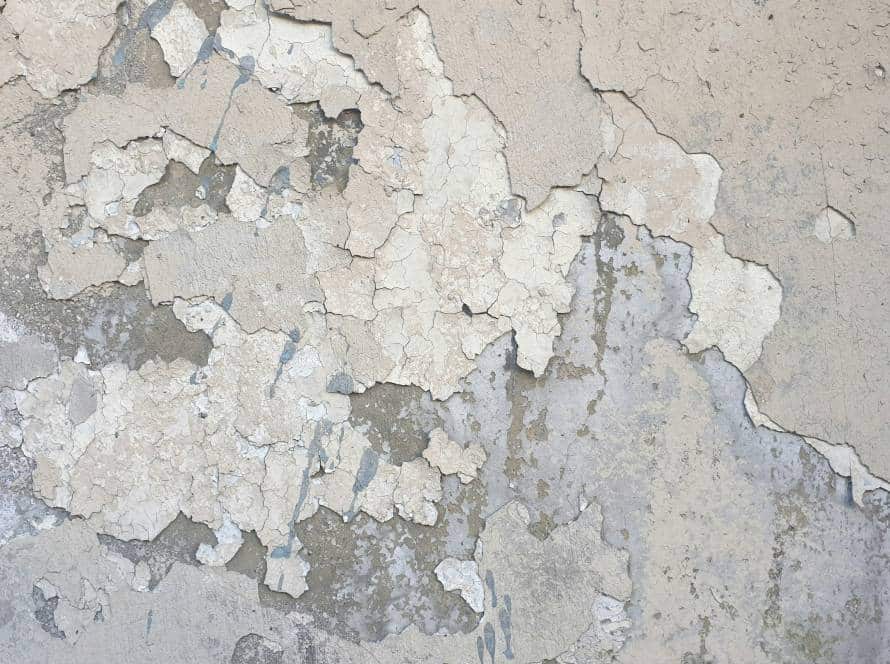Your Charleston historic home tells stories through every wall, but modern paint can silence those voices forever. Latex paint over 200-year-old lime plaster doesn’t just cover history. It traps moisture. That moisture bubbles, peels, and damages walls built to last centuries. Historic home interior painting in Charleston needs a different approach than your neighbor’s new house.
We at Wade Paint Co. have painted interiors in Charleston’s most treasured homes from old mansions on Tradd Street to Victorian houses across the peninsula. These homes taught us something important. Good preservation isn’t just about looks. It’s about respecting materials that survived hurricanes, earthquakes, and centuries of Charleston’s tough coastal weather.
This guide demonstrates the specialized techniques that preserve historic interiors’ beauty and integrity. You’ll learn why breathable paint matters, which colors belong in your period home, and how the right prep work protects your investment for generations. Planning one room or a whole house? These principles help you honor your home’s past while meeting today’s needs.
Read below to see how professional interior painting services preserve Charleston’s historic treasures?
Why Your Historic Charleston Home Needs Special Care

Charleston’s coastal climate creates a perfect storm for historic homes. Salt air from the harbor works its way into every crack and summer humidity hits 90% regularly. Winter brings sudden temperature drops that make walls expand and contract like accordions. Your historic home faces challenges that didn’t exist when it was built.
Most old Charleston homes have original lime plaster walls which are made with lime, sand, and horsehair or Spanish moss. It breathes naturally. Modern latex paint acts like plastic wrap over these walls. It seals the surface completely. Moisture gets trapped underneath and has nowhere to go.
Here’s what happens next. The trapped moisture builds pressure and paint starts bubbling within months. Then it peels in sheets. Worse yet, that moisture damages the original plaster underneath. We’ve seen homeowners spend thousands trying to fix problems that started with the wrong paint choice.
The old brick in Charleston homes adds another challenge. Most historic homes used lime mortar between bricks that also needs to breathe. Paint the wrong primer on these walls and you block this natural moisture system. The result? Cracked mortar joints and expensive masonry repairs.
Charleston homeowners learn these lessons before they paint. The right materials and methods actually protect your investment. Wrong choices can create expensive problems that compound over time. We’ve helped restore homes where previous painters ignored these basics. Trust us – it’s much cheaper to do it right the first time.
Limewash and Clay Paints: Charleston’s Traditional Solutions
Historic Charleston homes need paint that breathes. Modern latex paints seal surfaces completely, but traditional paints work with your home’s natural moisture system instead of fighting it. The two best options for Charleston’s climate are limewash and clay-based paints.
| Paint Type | Strengths | Weaknesses |
| Limewash | Soaks deep into plaster and becomes part of the wallBreathes naturally and gets stronger over timeHigh pH stops mold and mildew growthDevelops beautiful character as it agesColors get deeper with natural variationsPerfect for Charleston’s humid climate | Needs skilled applicationSurface must be damp during applicationRequires thin coats built up slowlyNot a DIY-friendly projectCan streak if rushedHigher upfront cost |
| Clay Paints | Uses natural clay base with zero VOCsPerfect for enclosed historic spacesNatural texture adds depthRich, earthy colors suit Charleston homesLess prep work neededGood compatibility with lime plasterEasier application than limewash | Limited color options compared to modern paintsMay need more frequent touch-upsCan be more expensive than latexRequires specific primers on some surfacesNot as durable as limewash long-term |
When should you avoid modern latex paints?
Skip them when you’re painting over original lime plaster, horsehair plaster, or exposed brick with lime mortar. These surfaces need to breathe but latex paint traps moisture and creates the problems we talked about earlier. Save latex for newer drywall or areas where the original materials have already been sealed.
Authentic Charleston Historic Home Colors
Colors tell Charleston’s story. Each era brought different palettes that reflected the times, available materials, and cultural influences flowing through the city’s busy port. Getting the colors right isn’t just about looks. It connects your home to its authentic heritage.
Pre-1850 homes embraced earth-based colors. Early Charleston homes featured natural colors like warm ochres, deep reds, and rich browns. These colors were easy to find and matched well with lime-based systems. The National Park Service states that “paint color reflects the time, taste, values, and mood” in their historic painting guidance.
Charleston’s famous haint blue deserves special mention. This soft blue-green appears on porch ceilings throughout the historic district. It traces back to Gullah Geechee culture, where blue paint was believed to ward off evil spirits. Haint blue gives your home a true Charleston vibe as it links your space to the city’s rich culture.
Victorian era homes (1850-1900) got bolder. Rich jewel tones, deep greens, and warm golds became popular. Charleston homeowners could afford more expensive pigments as the city prospered. These colors showed wealth and sophistication. Many historic Charleston homes still wear Victorian-era color schemes that have been carefully maintained over decades.
Charleston green tells its own story. This deep, nearly black green began as a bright verdigris green on the shutters and trim. The copper-based pigment degraded over time into the distinctive dark shade we see today. Modern Charleston green paint looks aged but avoids the issues of old copper acetate pigments.
Research your home’s original palette. Look for clues in rarely painted areas like closet interiors or behind old fixtures. Original colors often hide under layers of later paint. Many Charleston homeowners discover surprising color combinations when they investigate their home’s paint history. Professional paint analysis can reveal the authentic colors that belong in your specific home.
Foundation Work That Preserves Your Home’s Integrity

Getting the surface ready matters more than the paint itself. Rush this step and even the best limewash or clay paint will fail. Charleston’s historic homes need special prep work that protects original materials while creating a solid base for new paint.
Start with plaster assessment. Most historic homes in Charleston have lime plaster walls, not modern gypsum. You can tell the difference with a simple test. Scrape a small sample and drop it in white vinegar. Lime plaster will bubble and fizz. Gypsum plaster won’t react at all. This matters because each type needs different repair materials.
Lime plaster repairs require lime-based mortars. Modern gypsum compounds are too hard and don’t move with the old plaster. When Charleston’s humidity changes, walls expand and contract. Mismatched repair materials crack and pop off. We’ve seen homeowners waste money on repairs that failed because they used the wrong materials.
Find and fix moisture sources first. Paint problems often start with water infiltration. Check for leaky gutters, missing roof tiles, or failed window glazing. Charleston’s driving rains find every weakness. Address these issues before painting, or you’ll likely need to repaint sooner than expected.
Historic brick walls present unique challenges. The original lime mortar joints need to breathe just as the plaster does. Seal these with modern pointing compound and moisture gets trapped. This leads to spalled bricks and expensive masonry repairs. Use lime-based mortars that match the original materials.
Timing your project with Charleston’s climate. Avoid painting during humid summer months if possible. Winter interior painting in Charleston offers ideal conditions, while spring and fall provide lower humidity and more stable temperatures. Limewash especially needs proper curing conditions. High humidity during application can cause uneven coverage or poor adhesion.
Surface cleaning comes next, but avoid harsh methods. Power washing can drive water into historic walls. Chemical strippers may damage original plaster surfaces. Hand scraping and gentle cleaning protect the substrate while removing loose paint and debris.
When to call restoration specialists. Some repairs exceed typical painting prep work. Extensive plaster damage, structural cracks, or decorative plasterwork need specialist attention. We work with qualified restoration professionals when projects require specialized skills. It’s more cost-effective to perform complex repairs correctly the first time than to repair damage caused by improper methods.
Professional Methods for Historic Preservation

Good technique separates amateur work from professional results. Historic surfaces don’t act like modern drywall. Instead, they need different tools, timing, and methods. Most painters never learn these skills. Get the technique wrong and you’ll see streaking, poor coverage, or early failure.
Surface prep without damage comes first. Historic plaster has texture and bumps that add character. Don’t sand these away trying to make it smooth. Light scuffing with fine sandpaper removes loose bits without destroying the original texture. We use special brushes and gentle scraping tools that clean without cutting into the plaster.
Charleston’s bumpy historic surfaces also need flexible methods. Stiff foam rollers can’t follow the curves and texture changes. Natural bristle brushes work better because they bend and flex in response to the surface. This gets better coverage in all the small dips and raised spots.
Primer choice makes or breaks the job. Not all primers work with breathable paint, so make sure to look for primers specifically designed for use on lime-based paints or old surfaces. These let moisture pass through while sticking properly.
Temperature and humidity timing are crucial in Charleston. Limewash applied during high humidity can develop white, chalky spots. Clay paints may not cure properly if applied when the temperature is over 85 degrees. We watch weather conditions closely and change our schedule when needed.
Multiple thin coats consistently outperform thick coats. Historical paints build coverage slowly through multiple thin layers. Applying full coverage in one thick coat can cause runs, sags, and uneven texture. Each coat should be dry before you apply the next one.
Working wet-into-wet takes skill and speed. With limewash, you need to keep a wet edge as you work across a wall. Stop in the middle and you’ll see lap marks where sections meet. Professional teams work together to finish entire walls without stopping.
Brush technique changes the final look. Cross-hatch patterns work well for clay paints. They create subtle texture changes. Limewash looks best with steady strokes that follow the wall’s natural lines. We train our painters in these traditional methods that work in harmony with the natural character of historic materials.
Charleston’s Most Trusted Historic Home Painters

We’ve painted some of Charleston’s most treasured homes, from grand mansions on Tradd Street to Victorian cottages across the peninsula. These projects taught us that historic home painting is different from regular house painting. Every job needs special knowledge and careful planning.
Our team knows Charleston’s historic homes inside and out. We’ve worked on homes dating back to the 1700s and the early 1900s as each era has its own challenges. We study the history of your home before we begin work. This helps us choose the right materials and methods.
Charleston’s coastal climate creates unique problems. Salt air, high humidity, and sudden weather changes test every paint job. We’ve identified which products withstand these conditions. More importantly, we know which ones fail quickly and this experience saves our clients money and frustration.
We work with preservation specialists when needed. Some historic homes need more than painting. They may need plaster restoration, window repairs, or structural work. We have established relationships with qualified craftspeople who possess a deep understanding of historic preservation. This teamwork approach gets better results than trying to handle everything ourselves.
One recent project involved a 1850s home with original horsehair plaster walls. Previous painters had used latex paint that trapped moisture. We carefully removed the failing paint, repaired the plaster with lime-based materials, and applied breathable limewash. The homeowner was amazed at how much brighter and healthier the rooms felt.
We also handle exterior historic painting projects. Interior and exterior work often go hand in hand on historic homes. Windows, trim, and porches need the same careful approach as interior walls. Our experience with both sides of historic preservation enables us to coordinate comprehensive projects.
Fair pricing and clear communication set us apart. Historic home projects take longer than standard painting jobs. We explain why each step matters. Clients understand the value of doing things right. Many become repeat customers who trust us with their most important restoration projects.
Protecting Your Investment in Charleston’s Climate
Good historic painting lasts longer than regular paint jobs, but Charleston’s tough climate still takes its toll. Smart maintenance keeps your paint looking great and protects the investment you made in proper materials and methods.
Check your paint twice a year. Spring and fall are ideal times for quick inspections, such as checking for small cracks, peeling spots, or color changes. Catch problems early and fixes stay small and affordable. Wait too long and small touch-ups become major repainting projects.
Charleston’s humidity and salt air hit some areas harder than others. Bathrooms, kitchens, and rooms with poor ventilation tend to exhibit problems first, and south-facing walls are more susceptible to sun damage. Areas near windows may show water stains from driving rain. Focus your inspection on these high-stress spots.
Touch-up work needs the right approach. You can’t just brush regular paint over limewash or clay paint. Use the same materials that were originally applied. Keep extra paint from your original project for small repairs. If you don’t have any left, we can color-match and provide compatible touch-up materials to replace them.
Clean your painted surfaces gently, as harsh chemicals can damage breathable paint systems. Mild soap and water are sufficient for most cleaning purposes. Avoid pressure washing interior walls because high pressure can drive water into historic plaster and cause new problems.
Plan for full repainting cycles. Even the best historic paint jobs need renewal every 8-12 years in Charleston’s climate. Limewash may require more frequent refreshing in high-traffic areas. Clay paints often last longer but may need spot repairs. We help clients plan these cycles so they can budget properly.
Seasonal maintenance makes a big difference. Clean gutters prevent water problems that damage paint. Fix small window leaks before they create stains. Check humidity levels in closed rooms during the summer months. These simple steps protect your paint investment and extend its life.
Ready to fix up your historic Charleston home the right way?
Wade Paint Co. has years of experience with the city’s best properties. We understand Charleston’s challenging climate and recognize the specific materials required for historic preservation. We’ve helped homeowners from downtown mansions to peninsula cottages.
Don’t trust your historic home to painters who treat it like a new house. The wrong approach creates costly problems that only get worse over time. Our team understands the distinction between restoration and regular painting. We use the right materials and proven methods, and we pay close attention to the details that historic homes require.
Call Wade Paint Co. today to talk about your historic home project. We work in Charleston, Mount Pleasant, West Ashley, Daniel Island, Isle of Palms, and Sullivan’s Island. Call (843) 474-5353 or email contact@wadepaintco.com. Learn how professional interior painting services can save your piece of Charleston history for your kids and grandkids.
Frequently Asked Questions
How much does historic home interior painting cost in Charleston compared to regular painting?
Historic home painting costs 20-40% more than normal painting jobs. The extra cost is due to special paints, such as limewash or clay paints, longer preparation time, and skilled labor. A typical Charleston historic home interior costs a lot more - often double what you'd spend on the same space in a new home. The higher price reflects the special skills and materials needed. You get longer-lasting results and better protection for your home's value.
Can I use regular paint if I prime the walls first in my old Charleston home?
No, regular latex paint over primer still creates problems on old surfaces. The primer might help it stick, but it doesn't fix the breathing issue. Charleston's humidity will still get trapped behind the paint. This leads to peeling, bubbling, and damage to plaster. Historic homes require paint systems that work in harmony with the existing materials, rather than against them. Good breathable paints actually last longer than regular paint on old walls.
What's the difference between limewash and regular paint for Charleston's historic homes?
Limewash soaks into plaster surfaces and becomes part of the wall. It breathes naturally, fights mold, and gets stronger over time. Regular paint sits on top like plastic wrap. In Charleston's humid weather, limewash handles moisture better and develops beautiful aging as time passes. Regular paint traps moisture and fails faster. Limewash also fills small cracks on its own, whereas regular paint reveals every flaw. The trade-off is that limewash requires skilled workers and incurs higher upfront costs.
How do I choose authentic period colors for my 1800s Charleston home?
Start by learning your home's exact age and building style. Pre-1850 homes often featured earth tones, such as ochre, reds, and browns. Victorian homes (1850-1900) could accommodate richer colors, such as deep greens and jewel tones. Look for paint scrapes in hidden areas like closets or behind trim work. The Historic Charleston Foundation worked with Sherwin-Williams to create real color collections. Professional paint analysis can also show your home's original colors, though this special service requires a moderate investment per room. Many Charleston homeowners find surprising color mixes under layers of later paint.



